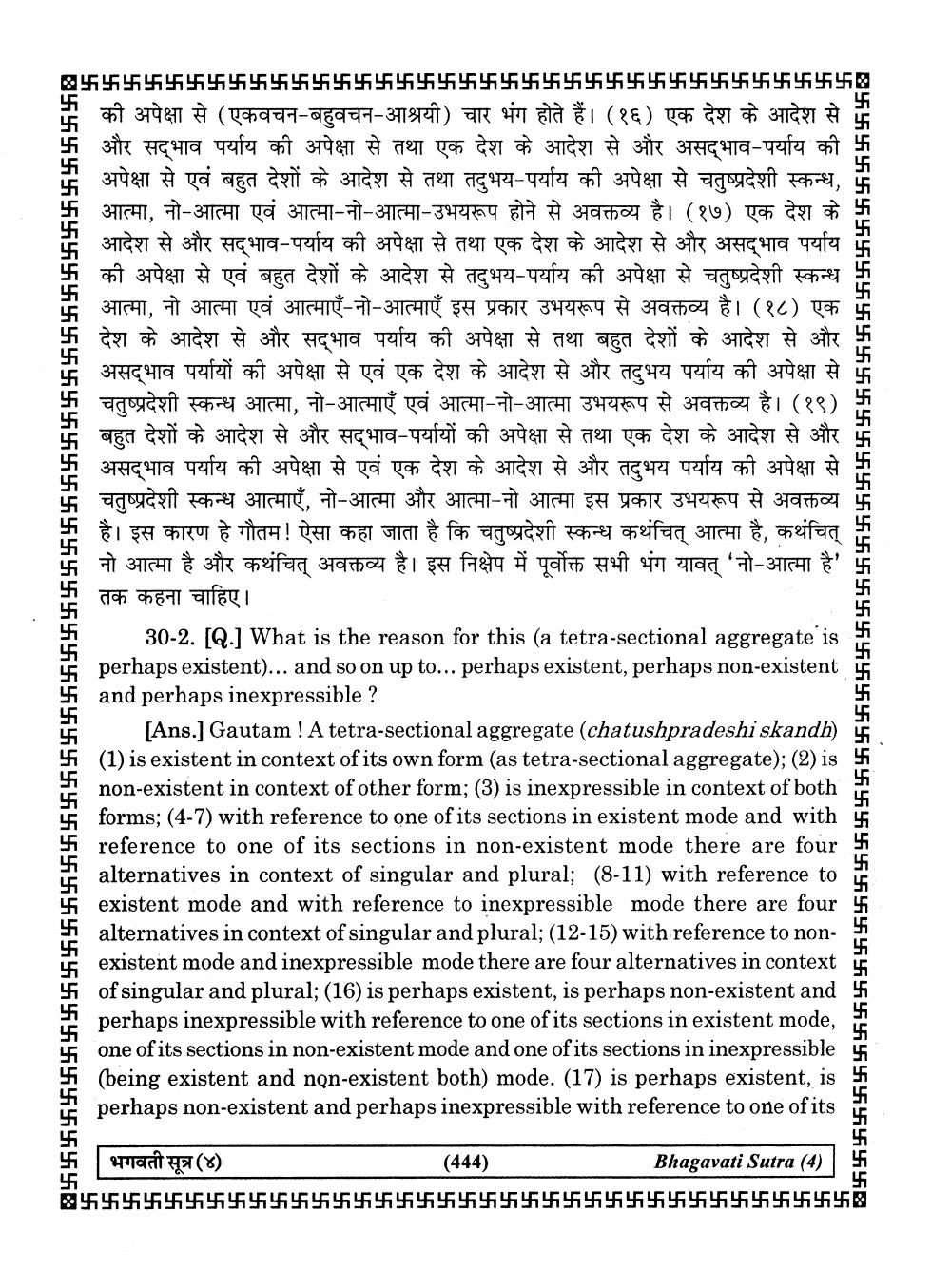________________
845555555555555555555555555558
की अपेक्षा से (एकवचन-बहवचन-आश्रयी) चार भंग होते हैं। (१६) एक देश के आदेश से 卐 और सद्भाव पर्याय की अपेक्षा से तथा एक देश के आदेश से और असद्भाव-पर्याय की 5 1 अपेक्षा से एवं बहुत देशों के आदेश से तथा तदुभय-पर्याय की अपेक्षा से चतुष्प्रदेशी स्कन्ध,
आत्मा, ना-आत्मा एव आत्मा-नो-आत्मा-उभयरूप होने से अवक्तव्य है। (१७) एक देश के 5
आदेश से और सद्भाव-पर्याय की अपेक्षा से तथा एक देश के आदेश से और असद्भाव पर्याय 卐 की अपेक्षा से एवं बहुत देशों के आदेश से तदुभय-पर्याय की अपेक्षा से चतुष्प्रदेशी स्कन्ध
आत्मा, नो आत्मा एवं आत्माएँ-नो-आत्माएँ इस प्रकार उभयरूप से अवक्तव्य है। (१८) एक 卐 देश के आदेश से और सद्भाव पर्याय की अपेक्षा से तथा बहुत देशों के आदेश से और म
असद्भाव पर्यायों की अपेक्षा से एवं एक देश के आदेश से और तदुभय पर्याय की अपेक्षा से है चतुष्प्रदेशी स्कन्ध आत्मा, नो-आत्माएँ एवं आत्मा-नो-आत्मा उभयरूप से अवक्तव्य है। (१९) बहुत देशों के आदेश से और सद्भाव-पर्यायों की अपेक्षा से तथा एक देश के आदेश से और
असद्भाव पर्याय की अपेक्षा से एवं एक देश के आदेश से और तदुभय पर्याय की अपेक्षा से ॐ चतुष्प्रदेशी स्कन्ध आत्माएँ, नो-आत्मा और आत्मा-नो आत्मा इस प्रकार उभयरूप से अवक्तव्य
है। इस कारण हे गौतम! ऐसा कहा जाता है कि चतुष्प्रदेशी स्कन्ध कथंचित् आत्मा है, कथंचित् 5 नो आत्मा है और कथंचित् अवक्तव्य है। इस निक्षेप में पूर्वोक्त सभी भंग यावत् 'नो-आत्मा है' तक कहना चाहिए।
30-2. [Q.] What is the reason for this (a tetra-sectional aggregate is perhaps existent)... and so on up to... perhaps existent, perhaps non-existent and perhaps inexpressible ?
[Ans. Gautam ! A tetra-sectional aggregate (chatushpradeshi skandh) (1) is existent in context of its own form (as tetra-sectional aggregate); (2) is non-existent in context of other form; (3) is inexpressible in context of both forms; (4-7) with reference to one of its sections in existent mode and with reference to one of its sections in non-existent mode there are four alternatives in context of singular and plural; (8-11) with reference to existent mode and with reference to inexpressible mode there are four 41 alternatives in context of singular and plural; (12-15) with reference to nonexistent mode and inexpressible mode there are four alternatives in context of singular and plural; (16) is perhaps existent, is perhaps non-existent and perhaps inexpressible with reference to one of its sections in existent mode, one of its sections in non-existent mode and one of its sections in inexpressible (being existent and non-existent both) mode. (17) is perhaps existent, is perhaps non-existent and perhaps inexpressible with reference to one of its
555555555555555555555;))))))))))))))))55555555555
भगवती सूत्र (४)
(444)
Bhagavati Sutra (4)




